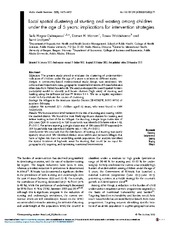Local spatial clustering of stunting and wasting among children under the age of 5 years: implications for intervention strategies
Peer reviewed, Journal article
Published version

View/
Date
2016-06Metadata
Show full item recordCollections
Original version
https://doi.org/10.1017/s1368980015003377Abstract
Objective: The present study aimed to evaluate the clustering of undernutrition indicators of children under the age of 5 years in relation to different scales. Design: A community-based cross-sectional study design was employed. We collected anthropometric data, geographic locations/elevations of households and other data from visited households. We used a retrospective purely spatial Poisson probability model to identify and locate clusters (high rates) of stunting and wasting using the software SaTScan™ version 9·1·1. We ran a logistic regression model to help evaluate the causes of clustering. Settings: Six villages in the Meskane Mareko District (38·45763°E, 8·042144°N) of southern Ethiopia. Subjects: We surveyed 2371 children aged <5 years, who were found in 1744 households. Results: We found a micro-level variation in the risk of stunting and wasting within the studied district. We found the most likely significant clusters for wasting and severe wasting in two of the six villages. For stunting, a single large cluster size of 390 cases (304·19 expected) in 756 households was identified (relative risk=1·48, P<0·01). For severe stunting, a single cluster size of 106 cases (69·39 expected) in 364 households was identified (relative risk=1·69, P =0·035). Conclusions: We conclude that the distribution of wasting and stunting was partly spatially structured. We identified distinct areas within and between villages that have a higher risk than the underlying at-risk population. Our analysis identified the spatial locations of high-risk areas for stunting that could be an input for geographically targeting and optimizing nutritional interventions.